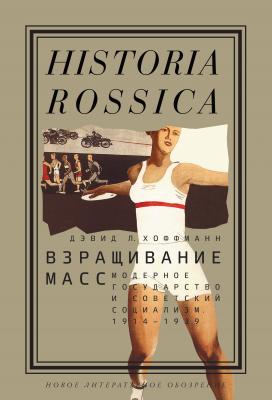ТОП просматриваемых книг сайта:
Взращивание масс. Дэвид Хоффманн
Читать онлайн.Название Взращивание масс
Год выпуска 2011
isbn 978-5-4448-1300-3
Автор произведения Дэвид Хоффманн
Жанр История
Серия Historia Rossica
Издательство НЛО
56
См.: Maier C. Between Taylorism and Technocracy: European Ideologies and the Vision of Industrial Productivity in the 1920s // Journal of Contemporary History. 1970. Vol. 5. No. 2. P. 27–61.
57
Blackbourne D. The Discreet Charm of the Bourgeoisie // The Peculiarities of German History / Eds.. D. Blackbourne and G. Eley. New York, 1984. P. 216.
58
Domansky Е. Militarization and Reproduction in World War I Germany // Society, Culture, and the State in Germany, 1870–1930 / Ed. G. Eley. Ann Arbor, 1996. Р. 430.
59
Elwitt S. The Third Republic Defended: Bourgeois Reform in France, 1880–1914. Baton Rouge, 1986. P. 23. Более подробное обсуждение см. в кн.: Rabinow Р. French Modern. Р. 169–170, 185–186.
60
Sullivan М. The Development of the British Welfare State. P. 13–15.
61
Gilbert В. The Evolution of National Insurance in Great Britain. London, 1966. Р. 13–14, 26, 98.
62
Searle G. R. The Quest for National Efficiency: A Study in British Politics and Political Thought, 1899–1914. Berkeley, 1971. Р. 60, 62, 82, 85.
63
Steinmetz G. Regulating the Social. P. 44, 198–202.
64
Crew D. The Ambiguities of Modernity: Welfare and the German State from Wilhelm to Hitler // Society, Culture, and the State in Germany. P. 323.
65
Peukert D. The Genesis of the «Final Solution». P. 238.
66
Ibid.; Idem. The Weimar Republic: The Crisis of Classical Modernity. London, 1991. Р. 187. Дэвид Крю, критикуя Пойкерта, отмечает, что он преувеличивает утопизм реформаторов и недооценивает разрушения Первой мировой войны, приведшие к крайней необходимости восстановления общества, что и лежало в основе радикализма веймарских программ и предельной степени государственного вмешательства, имевшей место в эпоху нацистов. См.: Crew D. The Ambiguities of Modernity. P. 325–326.
67
Crew D. The Ambiguities of Modernity. P. 323.
68
К примеру, в Аргентине социальные программы на государственном уровне появились только в 1940-е годы – как продолжение более ранних благотворительных инициатив, исходивших от филантропов, феминистов, иммигрантских общин и врачей. См.: Guy D. J. Women Build the Welfare State: Performing Charity and Creating Rights in Argentina, 1880–1955. Durham, 2009. P. 4–5.
69
Habermas J. The Structural Transformation of the Public Sphere: An Inquiry into a Category of Bourgeois Society / Transl. T. Burger. Cambridge (Mass.), 1989. P. 231. См. рус. пер.: Хабермас Ю. Структурное изменение публичной сферы: Исследования относительно категории буржуазного общества. М., 2016.
70
Engelstein L. Combined Underdevelopment: Discipline and the Law in Imperial and Soviet Russia // American Historical Review. 1993. Vol. 98. No. 2 (April). P. 344.
71
Bucur M. Eugenics and Modernization in Interwar Romania. Pittsburgh, 2002. Р. 64.
72
Garon S. Molding Japanese Minds: The State in Everyday Life. Princeton, 1997. P. 6–11, 352–354. После Первой мировой войны японское Министерство образования проводило «кампании по ежедневному улучшению жизни» при поддержке неправительственной Лиги за ежедневное улучшение жизни, диктовавшей людям нормы питания, гигиены, жилья и правильные рабочие привычки.
73
Schayegh C. Sport, Health, and the Iranian Middle Class in the 1920s and 1930s // Iranian Studies. 2002. Vol. 35. No. 4. P. 342–343. Подобно русским либерально настроенным ученым при советской власти, иранские интеллигенты не любили диктатуру Резы-шаха, установившуюся в результате переворота 1921 года, но с энтузиазмом участвовали в его программе модернизационных реформ, охотно делясь своими технократическими знаниями. См.: Idem. «A Sound Mind Lives in a Healthy Body»: Texts and Contexts in the Iranian Modernists’ Scientific Discourse of Health, 1910s–40s // International Journal of Middle East Studies. 2005. Vol. 37. Р. 168.
74
См.: The Zemstvo in Russia: An Experiment in Local Self-Government / Eds. T. Emmons and W. S. Vucinich. Cambridge; New York, 1982.
75
Paperno I. Suicide as a Cultural Institution. P. 67.
76
Zelnik R. E. Labor and Society in Tsarist Russia: The Factory Workers of St. Petersburg, 1855–1870. Stanford, 1971. P. 92, 381.
77
Steinmetz G. Regulating the Social. P. 106.
78
Hutchinson J. F. Politics and Public Health in Revolutionary Russia, 1890–1918. Baltimore, 1990. P. xix – xx. См. также: Frieden N. M. Russian Physicians in an Era of Reform and Revolution, 1856–1905. Princeton,

